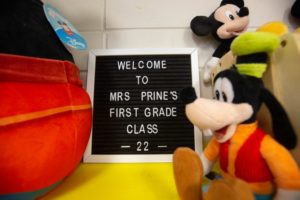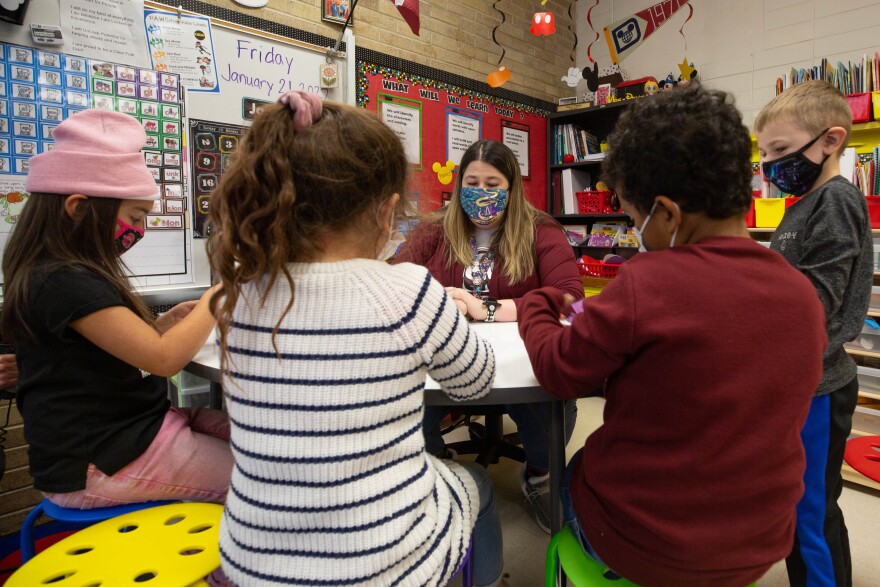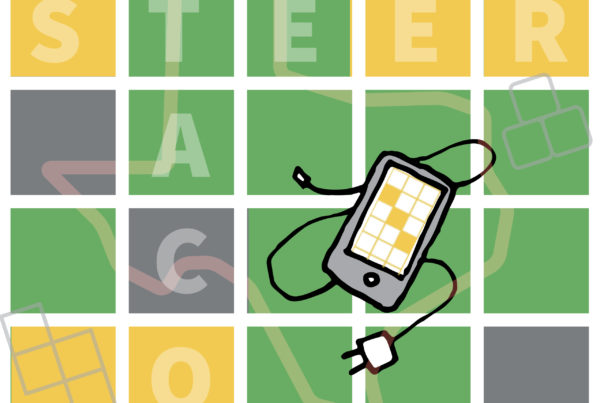Holly Prine stands in front of the white board in her classroom at Clear Fork Elementary School in Lockhart. She asks the first-grade students sitting on the colorful carpet in front of her to name words with the sound “or” in them.
“Door!” one student shouts.
“Corn!” says another. “I said corn first!”
She turns her back to grab a marker, and in those few seconds, the group’s attention falls apart. One student is crawling under a table, others start talking to each other, a few roll around on the carpet.
As she’s talking about the word “corn,” Prine interrupts herself.
“Oh, I’ll wait. Let me wait for it to be quiet,” she says. “Is this how we’re going to sit on the carpet?”
It takes a full minute for her to get the students seated, quiet and looking at her.
Teachers must often redirect their students, but Prine and many other first-grade teachers in Central Texas say the children’s behavior this year is abnormal.
“They’re excellent at transitioning out of the classroom,” Prine says. “Time to go to lunch, they know how to handle that. Transitions in the room are a little different, because it’s like if they don’t have an activity to do immediately, they’re going to go talk to each other.”
Teachers from a number of schools say first-grade students are having a tough time following the rules of a classroom. Many are spending their days trying to get them to focus.
And they all say it’s because of the pandemic.
First time in a classroom
The transition back to in-person learning was difficult for a lot of students, but first-graders are having a unique experience. In March 2020, they were just 4 years old. Some might have been in pre-K, but most hadn’t started formal schooling yet. Then, their kindergarten experience was mostly virtual.

Prine says this school year is more chaotic than years past. Patricia Lim/KUT
Missing out on kindergarten means missing out on crucial lessons about how to act in school: to keep your hands to yourself when you line up, to put a quiet bubble in your mouth while walking, to sit on the carpet crisscross applesauce.
Every other school-aged kid had some experience with being in a classroom before being sent home because of COVID. But not these kids.
Prine says there’s always a transition at the beginning of a school year to remind kids of the rules, but that it shouldn’t still be this chaotic in the second semester.
She says she has a lot to catch them up on, like solidifying reading skills. She’s also having to work really hard on handwriting, a skill students are introduced to in kindergarten. Last year, the students spent most of the year online, and there was no guarantee that parents would work with them on handwriting the way a teacher would.
Prine says she can get stressed about their progress, because her main goal as a first-grade teacher is getting these kids to read and write.
“That’s what we’re really focused on,” she says. “And that’s the thing that keeps a first-grade teacher up at night, is the reading.”
Age-appropriate acting out
This isn’t a story about how these first-graders are doomed because of the pandemic. In fact, it might be the opposite. According to Jennifer Keys Adair, a professor of early childhood education at UT Austin, the pandemic might have exposed a new way of thinking about this age group.
Adair says activities like sitting still for 20 minutes or doing solo work — while normal in the American education system — is not normal for a 6- or 7-year-old brain.
“The desire to help one another and be with one another and to learn with one another is really strong at that age,” she says. “Between the ages of 3 to 8 [is] when children are learning who they are in relation to everyone else.”
Adair says acting antsy isn’t a sign that the first-graders in Lockhart are struggling with school; that’s how any kid that age would act. Not learning the social cues in kindergarten just exposes how they naturally want to learn — with each other.
“When they’re observing what’s going on at another station, they’re learning,” she says. “When they have a conversation and a kid is free to shout out that they figured something out and everybody can run over and look at it, they’re learning from that. But if you’re in a classroom where you can’t be excited, you can’t raise your voice, you can’t call others over when you do something exciting — all of those learning opportunities are shut down.”

This isn’t new information to teachers like Prine. She sees this instinct in her students every day.
“That need for socialization and being around each other overrides that need to follow directions,” she says. “They don’t feel like that urgency, because it’s like, ‘No, what I really need to do is go talk to my friend.”
But Prine works in a school system that says reading must be strong by first grade and even better by second grade, so that by third grade students can take a standardized test and do so well the district stays in the good graces of the State of Texas.
That, says Adair, is not how early grades should be taught.
In much of Western Europe and countries like Estonia, students don’t start learning to read until first grade, she says. Starting in kindergarten became popular in the U.S. only after standardized tests came around. So, while teachers are frustrated about the way students are behaving, Adair says it’s completely in line with how a 6-year-old should act.
“If the goal is to get them quiet and that’s how you’re going to know you’re a good teacher, this has got to be frustrating,” she says. “But the problem is teachers have to shift along with their principals, otherwise it’s not really fair.”
While the students in Prine’s class were often not sitting still during the lesson, they were still shouting out words that contained “or” and sounding out the words. They were excited to learn; they just weren’t following the standard expectations for a classroom.
After the lesson on the carpet, the students went to stations to complete different activities. Three students sat down at a table to practice their handwriting. Two girls carefully traced letters on a laminated page in front of them. The third wrote as fast as he could, the letters messy, not at all tracing over the ones on the page.
He finished the final letter and shouted: “I’m the fastest!”
“It’s not a race,” the girl next to him said.
The boy looked at her page, with the carefully traced letters, and then back down at his own. He erased his page and started over, going much slower this time.
He learned from his classmate which, according to Adair, will stick with him more than if an adult had corrected him.














